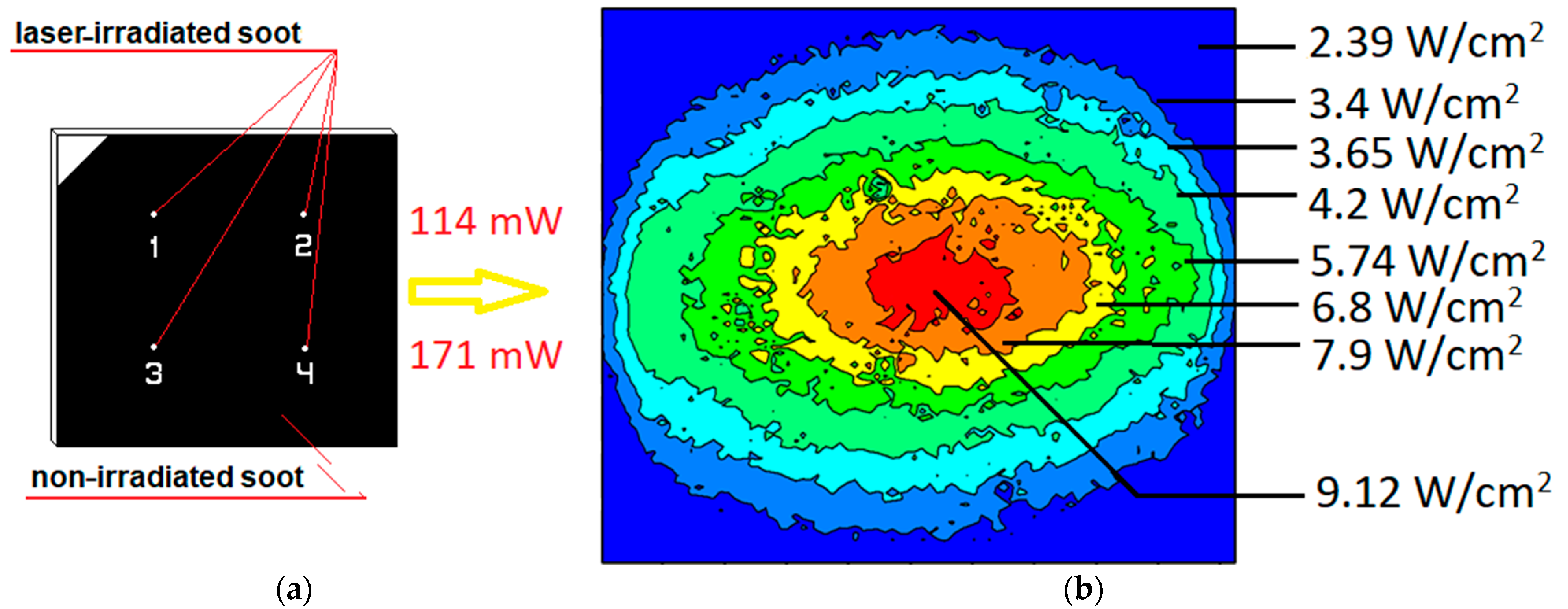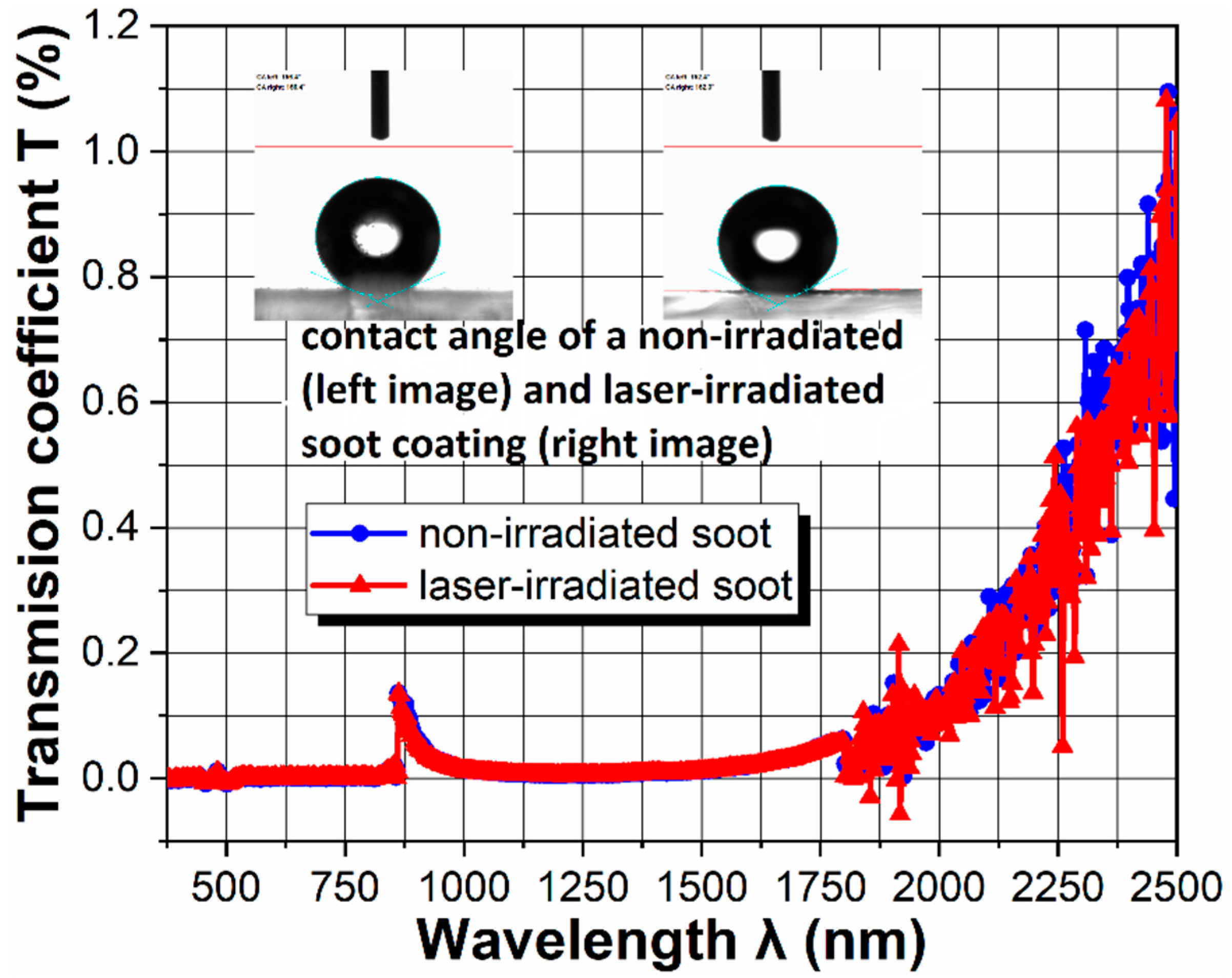Laser Irradiation of Super-Nonwettable Carbon Soot Coatings–Physicochemical Implications
Abstract
:Author Contributions
Funding
Data Availability Statement
Acknowledgments
Conflicts of Interest
References
- Bond, T.C.; Doherty, S.J.; Fahey, D.W.; Forster, P.M.; Berntsen, T.; DeAngelo, B.J.; Flanner, M.G.; Ghan, S.; Kärcher, B.; Koch, D.; et al. Bounding the role of black carbon in the climate system: A scientific assessment. J. Geophys. Res. Atmos. 2013, 118, 5380–5552. [Google Scholar] [CrossRef]
- Esmeryan, K.D.; Lazarov, Y.; Stamenov, G.S.; Chaushev, T.A. When condensed matter physics meets biology: Does superhydrophobicity benefiting the cryopreservation of human spermatozoa? Cryobiology 2020, 92, 263–266. [Google Scholar] [CrossRef] [PubMed]
- Esmeryan, K.D.; Stamenov, G.S.; Chaushev, T.A. An innovative approach for in-situ detection of postejaculatory semen coagulation and liquefaction using superhydrophobic soot coated quartz crystal microbalances. Sens. Actuators A Phys. 2019, 297, 111532. [Google Scholar] [CrossRef]
- Esmeryan, K.D.; Castano, C.E.; Chaushev, T.A.; Mohammadi, R.; Vladkova, T.G. Silver-doped superhydrophobic carbon soot coatings with enhanced wear resistance and anti-microbial performance. Colloids Surf. A Physicochem. Eng. Asp. 2019, 582, 123880. [Google Scholar] [CrossRef]
- Zulfiqar, U.; Hussain, S.Z.; Subhani, T.; Hussain, I.; Rehman, H. Mechanically robust superhydrophobic coating from sawdust particles and carbon soot for oil/water separation. Colloids Surf. A Physicochem. Eng. Asp. 2019, 539, 391–398. [Google Scholar] [CrossRef]
- Xu, Y.; Zhang, G.; Li, L.; Xu, C.; Lv, X.; Zhang, H.; Yao, W. Icephobic behaviors of superhydrophobic amorphous carbon nano-films synthesized from a flame process. J. Colloid Interface Sci. 2019, 552, 613–621. [Google Scholar] [CrossRef] [PubMed]
- Komlenok, M.S.; Arutyunyan, N.R.; Freitag, C.; Zavedeev, E.V.; Barinov, A.D.; Shupegin, M.L.; Pimenov, S.M. Effect of tungsten doping on laser ablation and graphitization of diamond-like nanocomposite films. Opt. Laser Technol. 2021, 135, 106683. [Google Scholar] [CrossRef]
- Li, W.; Gao, L.; Ma, Z.; Wang, F. Ablation behavior of graphite/SiO2 composite irradiated by high-intensity continuous laser. J. Eur. Ceram. Soc. 2017, 37, 1331–1338. [Google Scholar] [CrossRef]
- Santiago, E.V.; Lopez, S.H.; Camacho Lopez, M.A.; Contreras, D.R.; Farias-Mancilla, R.; Flores-Gallardo, S.G.; Hernandez-Escobar, C.A.; Zaragoza-Contreras, E.A. Optical properties of carbon nanostructures produced by laser irradiation on chemically modified multi-walled carbon nanotubes. Opt. Laser Technol. 2016, 84, 53–58. [Google Scholar] [CrossRef]
- Vander Wal, R.L.; Choi, M.Y. Pulsed laser heating of soot: Morphological changes. Carbon 1999, 37, 231–239. [Google Scholar] [CrossRef]
- Stipe, C.B.; Choi, J.H.; Lucas, D.; Koshland, C.P.; Sawyer, R.F. Nanoparticle production by UV irradiation of combustion generated soot particles. J. Nanopart. Res. 2004, 6, 467–477. [Google Scholar] [CrossRef] [Green Version]
- Lee, C.B.; Shin, H.D. The effects of radiation shield and laser heating on the soot formation and oxidation of diffusion flame. JSME Int. J. 2005, 48, 279–285. [Google Scholar] [CrossRef] [Green Version]
- Michelsen, H.A.; Tivanski, A.V.; Gilles, M.K.; van Poppel, L.H.; Dansson, M.A.; Buseck, P.R. Particle formation from pulsed laser irradiation of soot aggregates studied with a scanning mobility particle sizer, a transmission electron microscope and a scanning transmission X-ray microscope. Appl. Opt. 2007, 46, 959–977. [Google Scholar] [CrossRef] [PubMed]
- Thomson, K.A.; Geigle, K.P.; Köhler, M.; Smallwood, G.J.; Snelling, D.R. Optical properties of pulsed laser heated soot. Appl. Phys. B 2011, 104, 307–319. [Google Scholar] [CrossRef]
- Sanchez-Arevalo, F.M.; Garnica-Palafox, I.M.; Jagdale, P.; Hernandez-Cordero, J.; Rodil, S.E.; Okonkwo, A.O.; Robles-Hernandez, F.C.; Tagliaferro, A. Photomechanical response of composites based on PDMS and carbon soot nanoparticles under IR laser irradiation. Opt. Mater. Express 2015, 5, 1792–1805. [Google Scholar] [CrossRef]
- Donate-Buendia, C.; Torres-Mendieta, R.; Pyatenko, A.; Falomir, E.; Fernandez-Alonso, M.; Minguez-Vega, G. Fabrication by laser irradiation in a continuous flow jet of carbon quantum dots for fluorescence imaging. ACS Omega 2018, 3, 2735–2742. [Google Scholar] [CrossRef] [PubMed]
- Migliorini, F.; De Iuliis, S.; Donde, R.; Commodo, M.; Minutolo, P.; D’Anna, A. Nanosecond laser irradiation of soot particles: Insights on structure and optical properties. Exp. Therm. Fluid Sci. 2020, 114, 110064. [Google Scholar] [CrossRef]
- Esmeryan, K.D.; Castano, C.E.; Fedchenko, Y.I.; Mohammadi, R.; Miloushev, I.K.; Temelkov, K.A. Adjustable optical transmittance of superhydrophobic carbon soot coatings by in-situ single-step control of their physicochemical profile. Colloids Surf. A Physicochem. Eng. Asp. 2019, 567, 325–333. [Google Scholar] [CrossRef]
- Mialichi, J.R.; Brasil, M.J.S.P.; Iikawa, F.; Verissimo, C.; Moshkalev, S.A. Laser irradiation of carbon nanotube films: Effects and heat dissipation probed by Raman spectroscopy. J. Appl. Phys. 2013, 114, 024904. [Google Scholar] [CrossRef]
- Esmeryan, K.D. From extremely water-repellent coatings to passive icing protection–principles, limitations and innovative application aspects. Coatings 2020, 10, 66. [Google Scholar] [CrossRef] [Green Version]





| Soot Area | Irradiation Conditions | Chemical Element (at.%) | |||||
|---|---|---|---|---|---|---|---|
| C | O | Na | Mg | SI | Ca | ||
| non-irradiated | n/a | 79 | 15.6 | 0.7 | 0.3 | 3.8 | 0.6 |
| irradiated | p = 171 mW; tir ~350 s | 72 | 21.5 | 0.9 | 0.3 | 4.6 | 0.7 |
Publisher’s Note: MDPI stays neutral with regard to jurisdictional claims in published maps and institutional affiliations. |
© 2021 by the authors. Licensee MDPI, Basel, Switzerland. This article is an open access article distributed under the terms and conditions of the Creative Commons Attribution (CC BY) license (http://creativecommons.org/licenses/by/4.0/).
Share and Cite
Esmeryan, K.D.; Fedchenko, Y.I.; Yankov, G.P.; Temelkov, K.A. Laser Irradiation of Super-Nonwettable Carbon Soot Coatings–Physicochemical Implications. Coatings 2021, 11, 58. https://doi.org/10.3390/coatings11010058
Esmeryan KD, Fedchenko YI, Yankov GP, Temelkov KA. Laser Irradiation of Super-Nonwettable Carbon Soot Coatings–Physicochemical Implications. Coatings. 2021; 11(1):58. https://doi.org/10.3390/coatings11010058
Chicago/Turabian StyleEsmeryan, Karekin D., Yulian I. Fedchenko, Georgi P. Yankov, and Krassimir A. Temelkov. 2021. "Laser Irradiation of Super-Nonwettable Carbon Soot Coatings–Physicochemical Implications" Coatings 11, no. 1: 58. https://doi.org/10.3390/coatings11010058
APA StyleEsmeryan, K. D., Fedchenko, Y. I., Yankov, G. P., & Temelkov, K. A. (2021). Laser Irradiation of Super-Nonwettable Carbon Soot Coatings–Physicochemical Implications. Coatings, 11(1), 58. https://doi.org/10.3390/coatings11010058





